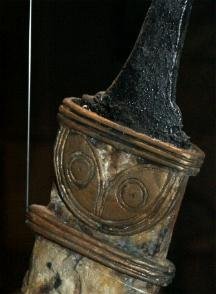Site Details:
Mote of Mark, Rockcliffe. Dumfries & Galloway 4 miles south of Dalbeattie NX 845540
Vitrified Fort
The Mote of Mark is a defended hilltop overlooking the Urr estuary. It was the court or citadel of a powerful Dark Age chieftain, possibly one of the princes of Rheged. The site was occupied during the 6th century and appears to have been destroyed by fire in the 7th century.
The top of the hill was enclosed by a massive stone and timber rampart. Inside was a timber hall surrounded by a huddle of workshops and stables. This was a wealthy site with trading contacts across Europe. Finds from the excavations include glass beads and wine jars from central France and glassware from Germany. Local craftsmen produced elegant bronze jewelry in a distinctive Celtic style.
The tumbled remains of the ramparts can still be seen and an on-site interpretation panel has an atmospheric reconstruction of the fort.
size: 8 ha (20a)
Legendary and Literary Background - https://panther.bsc.edu/~arthur/others.html This fort was occupied from the 5th to 7th centuries, smack dab in the Arthurian time frame. At the pinnacle of its prominence, it was a well-fortified trading and manufacturing center. Excavations in 1913 and 1973 unearthed a large, circular timber hut and evidence of metalworking. These people seemed to have imported raw materials--iron from the Lake District and jet from York--to produce interlaced jewelry, brooches, and sundry metalwork. They imported luxuries as well--pottery from Bordeaux and glass from the Rhineland were found. Such prosperity suggests that this fort may have been the stronghold of a smaller British subkingdom.
The primary defences consisted of stone and timber walls, and there was a timber gate for the main entrance on the southern slopes. In the 7th century, though, these defences failed. The outer wall shows evidence of vitrification, a condition when extreme heat causes stones to fuse together. Many believe that this was the result of an attack by the Angles--Anglian runic inscriptions were found at the site--though some say that the walls were purposely vitrified to strengthen them.
The only thing truly connecting this fort with the Arthurian legend is the name, its period of occupation, and its proximity to Trusty's Hill.
Site Gallery
Gallery Empty












